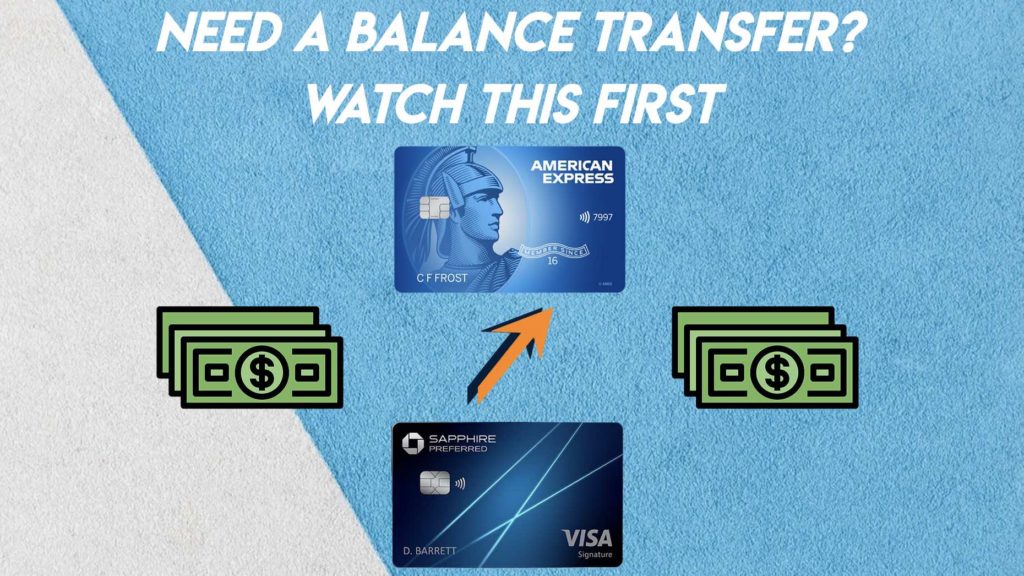by Daniel | Last Updated July 30th, 2022

We may earn a commission for purchases using our links, at no cost to you.
It’s not uncommon to have some debit on your credit card that is charging you a really high-interest rate and costing you a lot of money.
And there is proof of this, in a report from the Federal Reserve Bank of New York, Americans had a total credit card debt of $841 billion dollars in the first quarter of 2022
So if you do have debt on your credit card it might be beneficial to do a balance transfer to a new credit card that is offering a 0% introductory APR.
Now it’s not quite as simple as just getting any old credit card and just transferring your debt from one card to another, there are a few things that you should know before you embark on this process.
In this article, I wanted to go over everything you should know about getting a balance transfer, whether it is a good idea for you, and then how to actually complete the process.
What is a balance transfer?
So before I get into the finer details about how to perform a balance transfer, I thought It might be appropriate to talk about exactly what a balance transfer is and how it works.
In its simplest form, a balance transfer is when you move debt from one account (that usually has a high-interest rate) to another account (in this case one with a 0% APR specifically for balance transfers).
And if this is done correctly, it can potentially save you a lot of money as it will then be possible to pay off your debt interest-free.
Now, this all sounds nice and easy, but there are a few things you should know.
Each time you take advantage of a balance transfer it is quite normal for the card issuer to include specific costs and fees that are associated with the transaction depending on how much you transfer.

It is pretty common for each balance transfer to have a fee of around $5 to $10 or 3% to 5%, basically, the card issuer will charge whichever amount ends up being more.
So as an example a balance transfer of $10,000 that has a fee of 5% will cost $500, which is not cheap but can potentially be a lot less than having the same $10,000 in another account that is charging an APR of 18% or more.
So it makes sense to look for the lowest balance transfer fees possible, as it will most certainly save you more money.
Now with all of that being said, there are a few credit card issuers that do actually offer the ability to do a balance transfer with no fees at all.

One company that I found is First Tech Federal Credit Union which offers 4 different credit cards that have no annual fee and no fees associated with doing a Balance transfer, these cards are:
- Platinum Mastercard
- Platinum Rewards Mastercard
- Choice Rewards World Mastercard
- Platinum Secured Mastercard
Now it’s important to know that with these cards the 0% intro APR is for 12 months, and the transfer must be made within 90 days of opening the account.
Also, if you make any late payments during the 0% intro APR, they will most likely end your intro APR and apply a rate of between 8.49% and 18%.
Along with this, there will be a penalty fee of up to $25 for a missed payment.
And if you would like to learn more about these cards your can click here, and just so you know, this is not an affiliate link.
Now another thing to keep in mind with a balance transfer is that each card issuer will probably be offering a different time period for the 0% introductory APR.
And with so many different cards to choose from the time offered can vary a fair bit, from around 12 months to 21 months or more.
And finally, one of the most important points to remember with a balance transfer is that you should try to stay up to date with your monthly payments and never miss one.
As I mentioned before, If this happens, it is likely that you will be charged a penalty fee which can be up to $40 in some cases, and then the card issuer will usually take you off the 0% APR and implement a much high-interest rate.
When should you get a balance transfer?
Now a good question to ask yourself is do I need to get a balance transfer? and if the answer is yes, then why?
There are some clear benefits to getting a balance transfer which includes the ability to take advantage of an extremely low-interest rate, which is usually an introductory APR of 0%.
And this will be clearly beneficial to anyone that is currently carrying debt in an account that has a high-interest rate.
In this example, if you are able to take advantage of a 0% intro APR, assuming you make timely payments each month on the debt that is transferred, you will save a great deal of money.

But as I mentioned before, make sure to read the fine print of the credit card you are applying for, as there can be fees associated with the actual balance transfer, even though it has a 0% APR.
Also make sure to double check how long the intro APR is available to you as a new cardholder, as it is not unusual for the 0% APR to be available for the first month or two, then after this it may well revert back to a high-interest rate.
When you should NOT get a balance transfer
Now it might sound like a fantastic idea to go and get a balance transfer right now, as what can be better than receiving access to money with little to no cost?
Well, there are a few reasons why this is not the case and why you should be cautious when considering getting a balance transfer.
First of all, it’s worth considering how long you expect you will need to actually pay off the debt.
Generally speaking, if it’s at least 3 months to a year, then a balance transfer may be useful.
Just remember that most credit cards will charge a fee of around 3% to 5% just to transfer the debt.
And on a relatively large amount of money, this can add up, enough so that it may not make sense to get a balance transfer if you know you will be able to pay off the debt in a short period of time, say less than 3 months.

Another point to take into consideration is whether you have good credit or not.
This can be the deciding factor in whether you actually get approved by the card issuer for a balance transfer.
It’s not uncommon for most card issuers to require either good or excellent credit to be approved.
And ‘Good credit’ is usually a FICO score of at least 670.
Basically, the lower your credit score is the less likely it is that you will be approved for a balance transfer, and if you are, it is most likely that the credit limit will be quite low.
Finally, the last factor to take into consideration is if you have trouble making payments on time.
If you do get a balance transfer and for any reason, you miss a payment it is highly likely that the card issuer will take you off the 0% APR and replace it with a much higher APR, anything from around 8% to 30% if you’re unlucky.
And this will basically render the point of a balance transfer useless, as it will probably end up costing you more money than you were initially paying.
How to transfer your credit card balance
Now for the next section of this article, I’m going to take you through a few basic steps that you can take to do a balance transfer.
1. Find An Appropriate Balance Transfer Card
The first thing to do will be to find an appropriate credit card that is offering a 0% intro APR that meets your needs.
And if you want an example, I have made a couple of different videos in which I review a few card options, one being this video here — where I compare the American Express Blue Cash Everyday Card and the Chase Freedom Unlimited credit card. Both of which offer a 0% intro APR.
Another card option would be the credit cards I mentioned before.
Now just so you know, it’s most common to do a balance transfer from one card issuer to a totally different card issuer, so this means that same-issuer transfers are generally not allowed.
As an example, this would be like trying to transfer debit from a particular Chase credit card to another Chase credit card.
Now, remember that having a good credit score is important!
And when you do apply for this new credit card it is quite likely that the card issuer will perform a hard inquiry on your credit report, which can temporally impact your credit score.
2. Transfer the balance to your new credit card
So once you have found an appropriate credit card, applied for it, and received it, it will now be possible to initiate the balance transfer.
And this process shouldn’t be too difficult.
Generally, this can often be done online or over the phone with a representative.
And this is where you will need to provide information about the actual debt you want to transfer, so you will most likely need to inform them about how much the debt is and which credit card you will be transferring the debt from.
3. Wait for the transfer to finalize
Now from here, it will now take some time for the balance transfer to actually go through.
And this can take anywhere from a week to a month or longer.
During this time, don’t forget to continue making payments to the original card that you are transferring the debt from, as it would be a costly mistake to have a missed payment.
So once the transfer has gone through it should show up on your new account with the total balance that was transferred and the fee if any that they charged.
4. Pay off your balance owing
Now one of the most important parts of this whole process is to start constantly paying off your balance owing.
This means making all payments in full and on time to avoid any late payments.
And if you are able to pay off the debt quicker, I recommend you do that so as to avoid having to worry about owing debt any longer than need be.
Final thoughts
So there you have it, that pretty much covers everything you need to know about what a balance transfer is and how to do one.
And if you want to learn more about how to best use a credit card, check out this article, where I talk about some common mistakes that a lot of people make with their credit cards.
